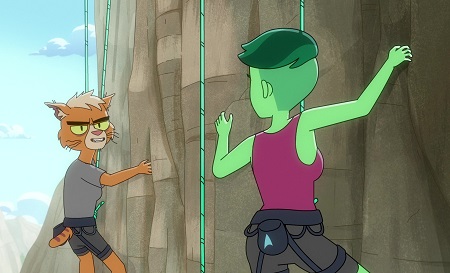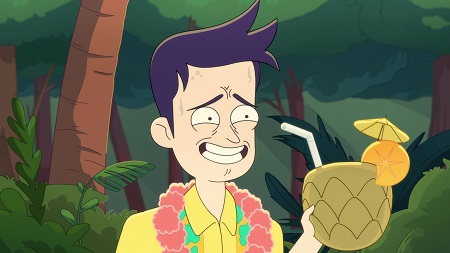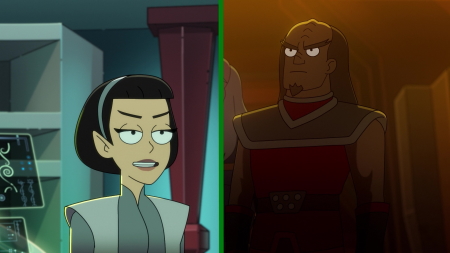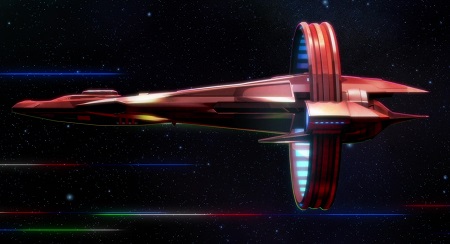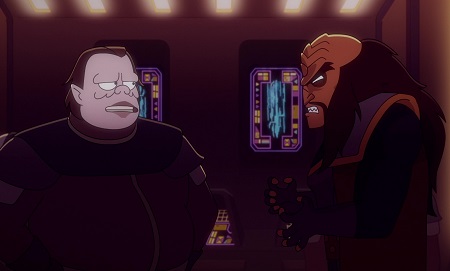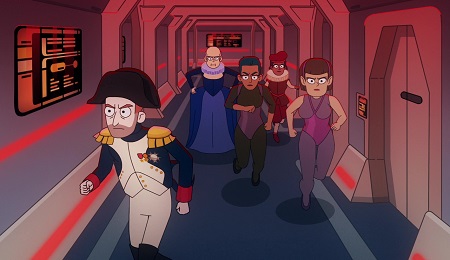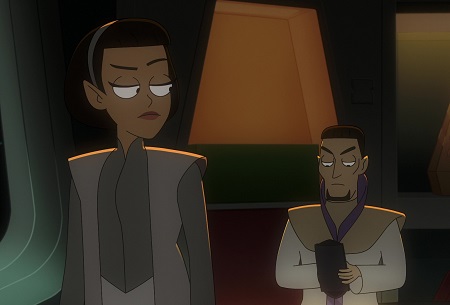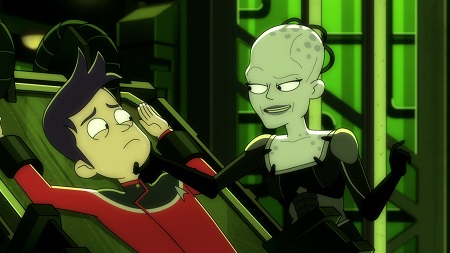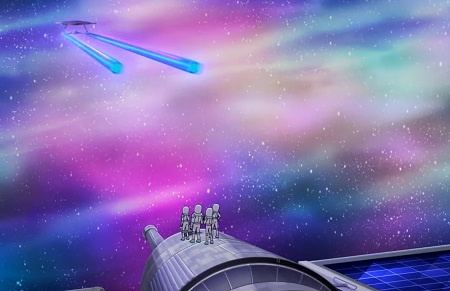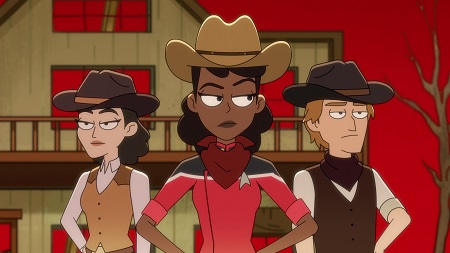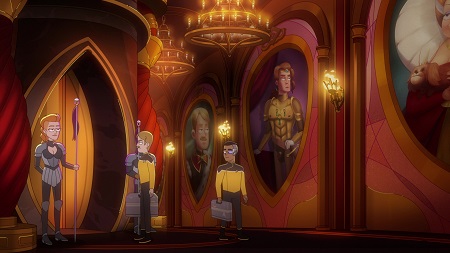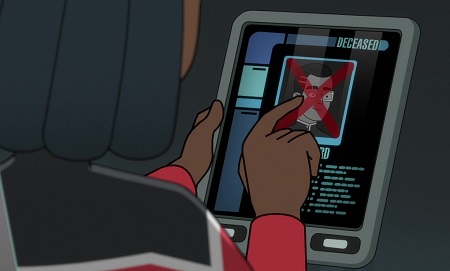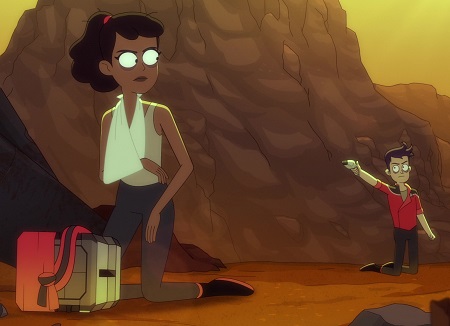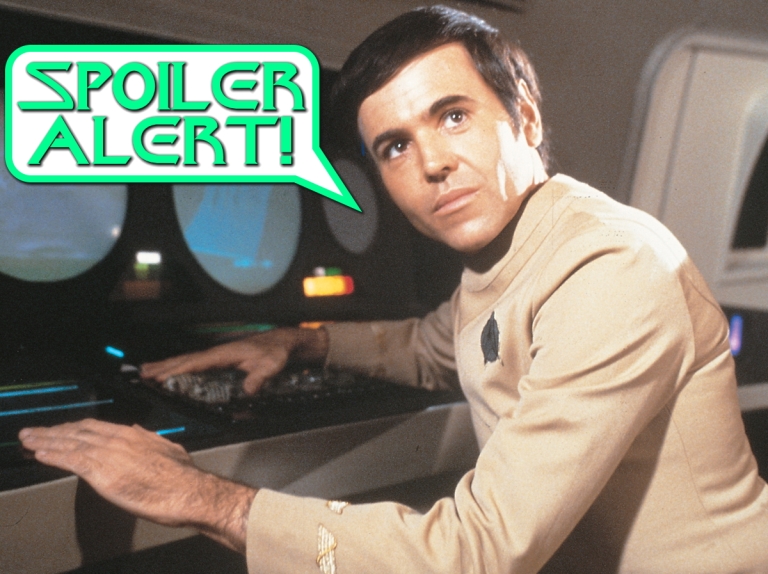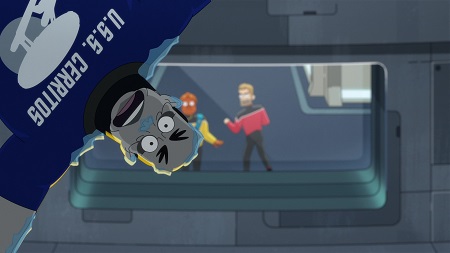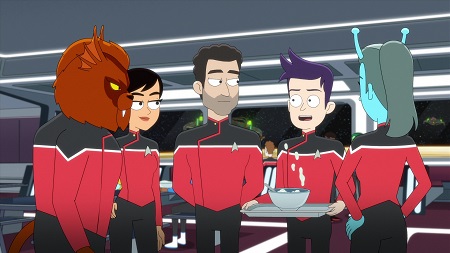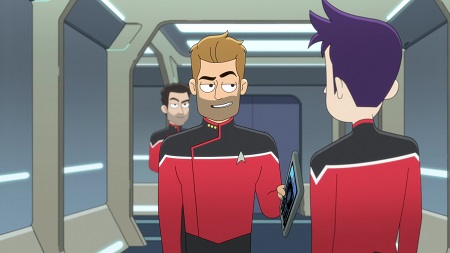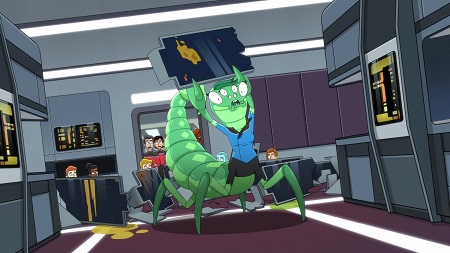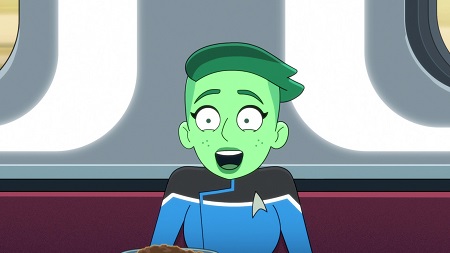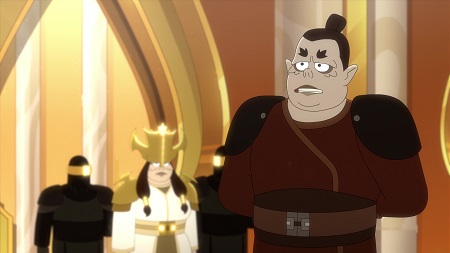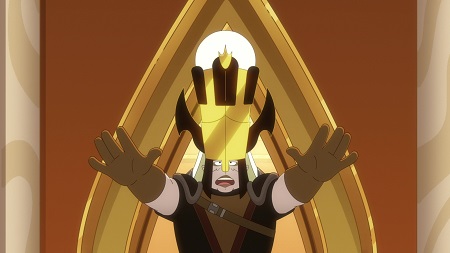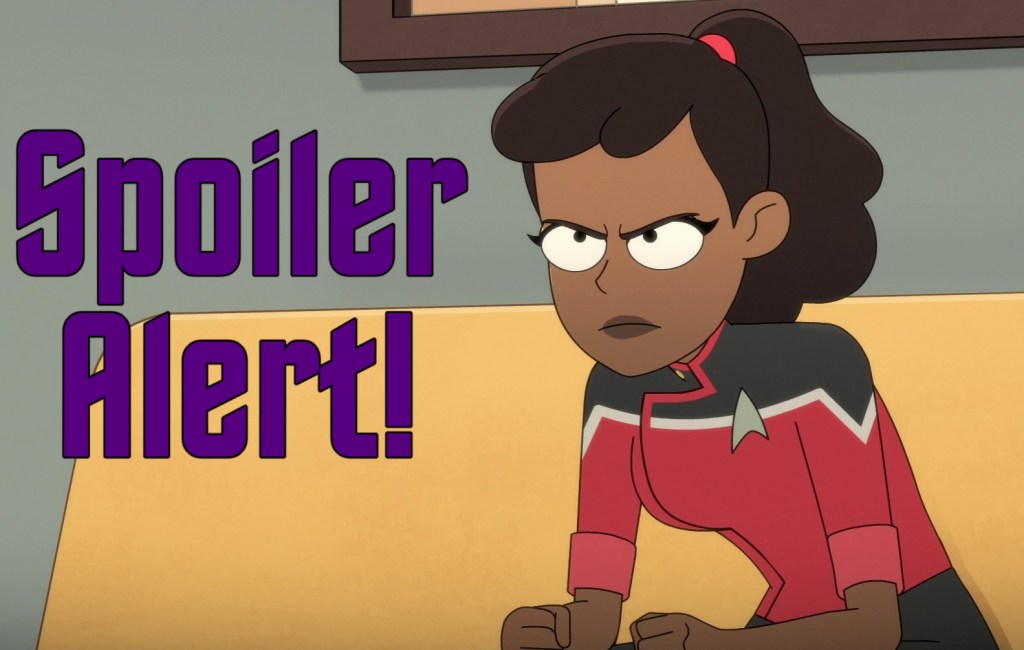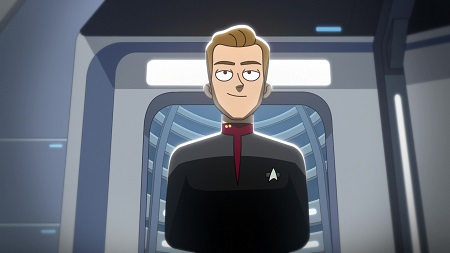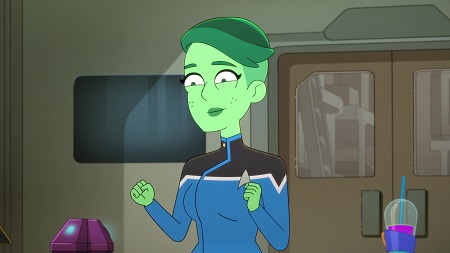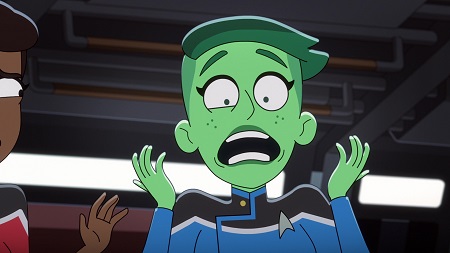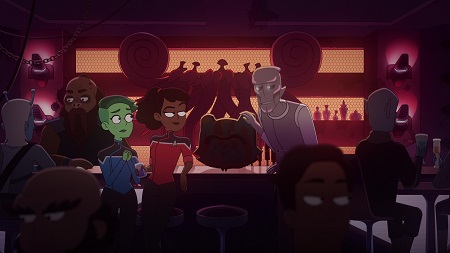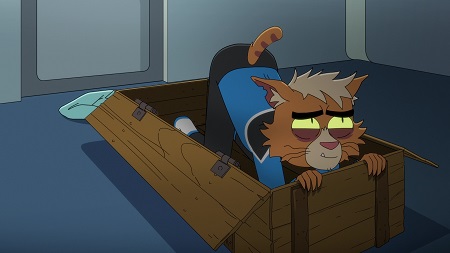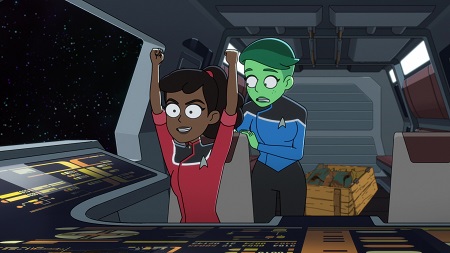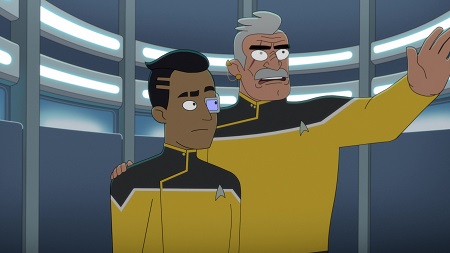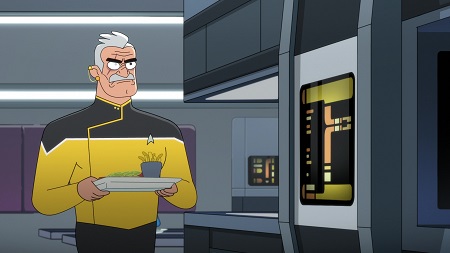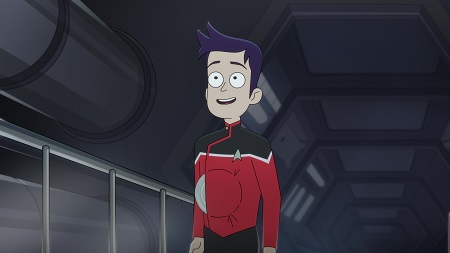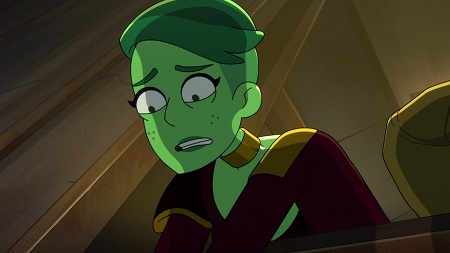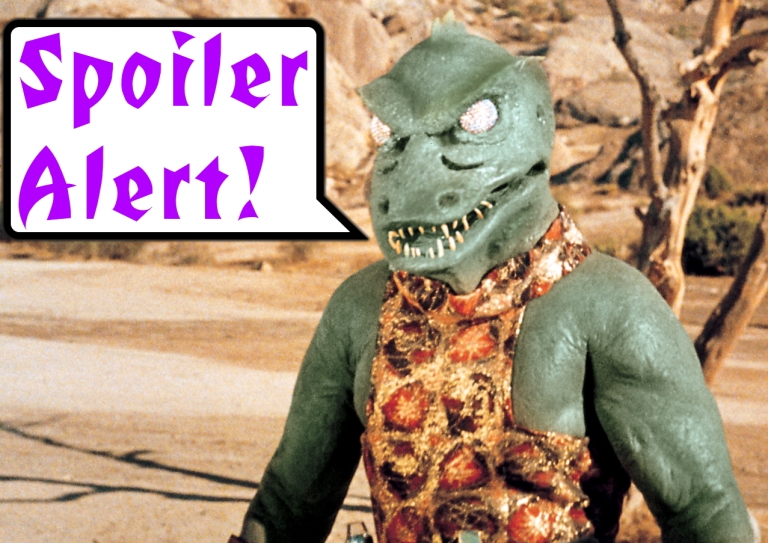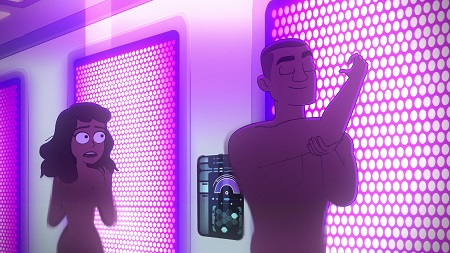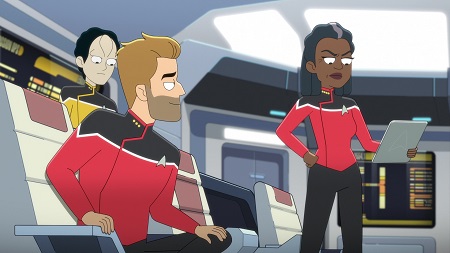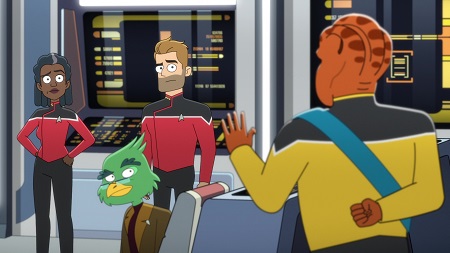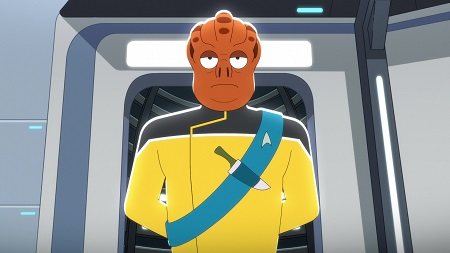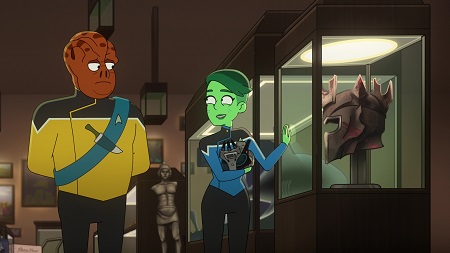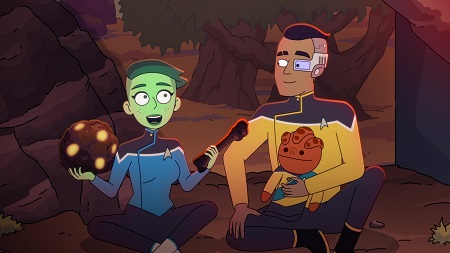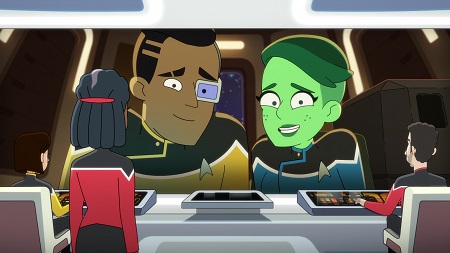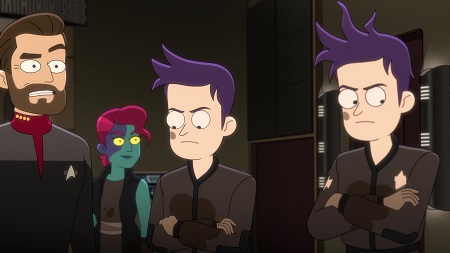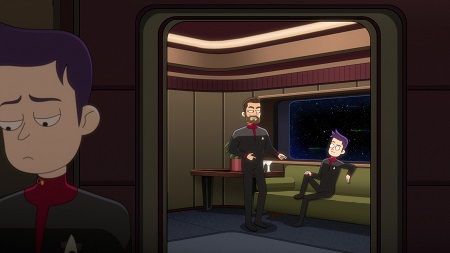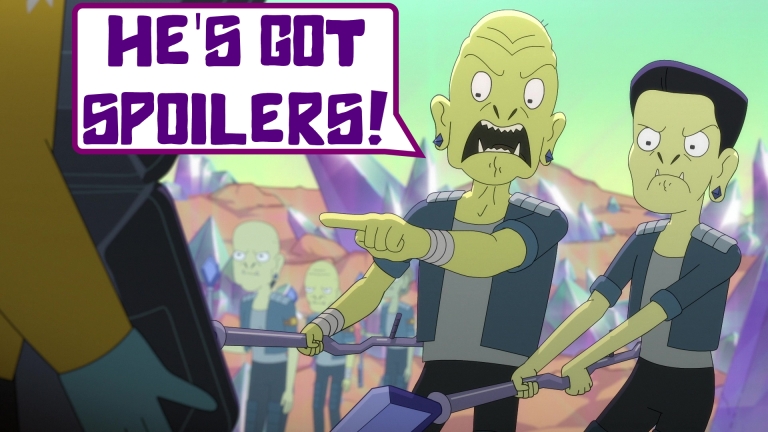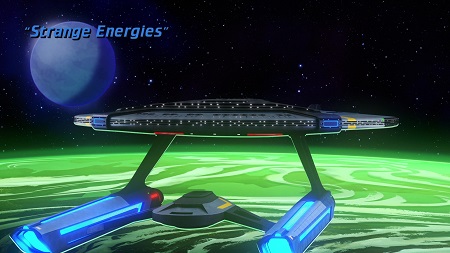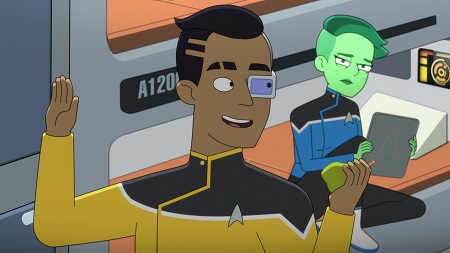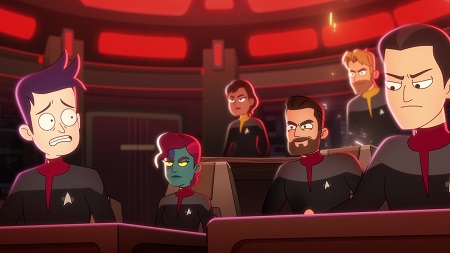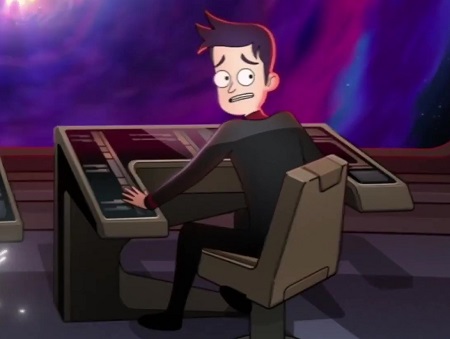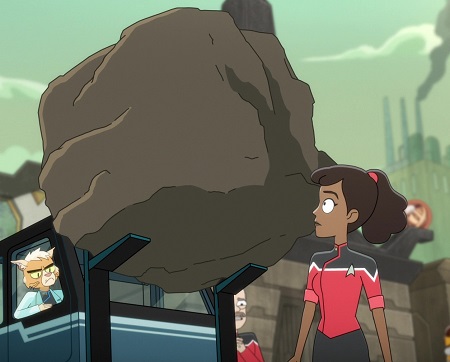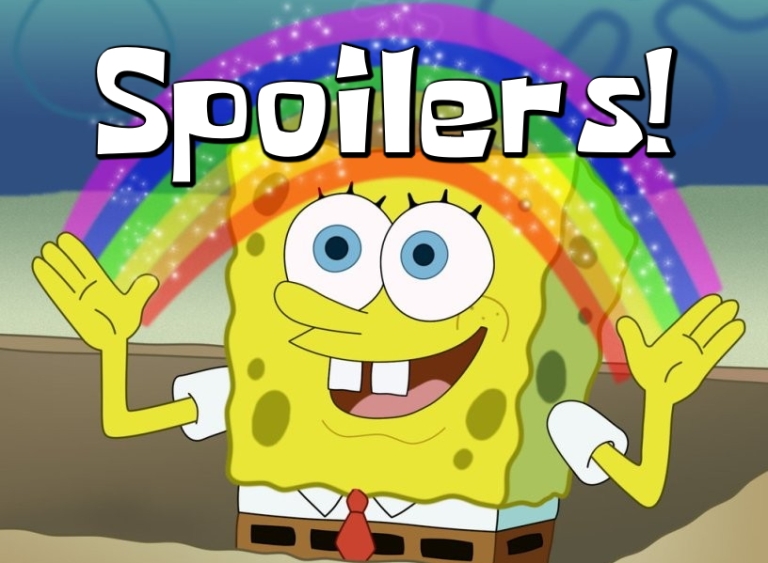
Spoiler Warning: There are spoilers ahead for Star Trek: Lower Decks Seasons 1-2. Spoilers are also present for the following Star Trek productions: Picard Season 1, Discovery Season 2, and The Next Generation.
Where has the time gone?! It seems like just yesterday that we were settling in for the premiere episode of Star Trek: Lower Decks Season 2, and now we’re already waving goodbye to the series as the season comes to an end. With a couple of weeks until Prodigy premieres – at least for folks lucky enough to have Paramount+ – and with Discovery Season 4 still a month away, there’s going to be a gaping hole in my entertainment schedule!
In the days ahead I’d like to take a look back at the season as a whole, so I hope you’ll stay tuned for that here on the website. But for now we’ve got one final episode to get stuck into, so let’s talk about First First Contact!
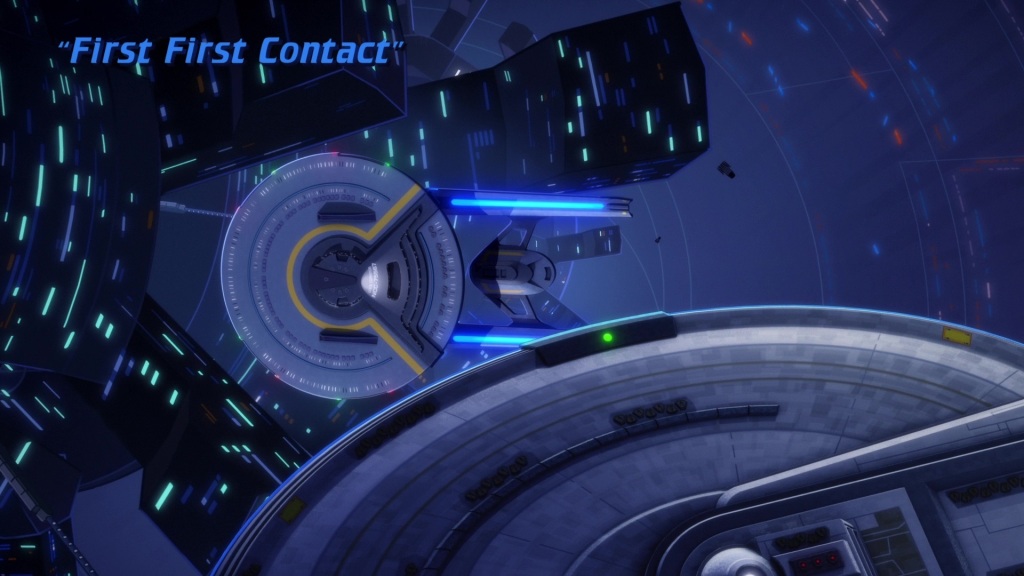
The episode was surprisingly emotional, presenting the crew with a difficult scientific problem to solve and pushing them to work together, harder than ever before, to save both a stricken starship in jeopardy and an entire planet. It brought back a well-liked character from The Next Generation, gave all four ensigns moments of character development, and had a stunning climax that both mirrored the finale of Season 1 while showing how far the Cerritos and her crew have come. And then, to cap it all off, First First Contact ended on a truly shocking cliff-hanger – one we’ll have to wait until next summer to see resolved!
Sometimes Lower Decks has felt like it’s bitten off more than it could chew, with too many characters and story threads in play such that some or all weren’t all they could have been. But despite First First Contact giving each of its main characters a role to play, as well as bringing in guest stars and recurring characters, it primarily stuck to one main story throughout and thus allowed everyone to participate in that story in a way that felt natural. No character felt under-used, and the story was well-paced.
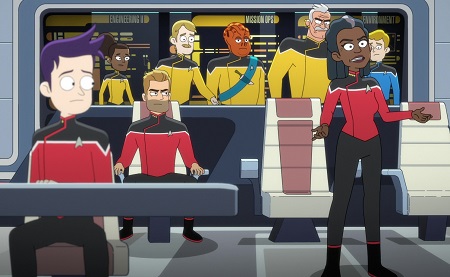
There were a handful of minor contrivances that we should acknowledge. In order to give all four ensigns a significant role in the story, particularly after three of the four were sidelined last week, the plot of First First Contact did include a little forced drama. There’s nothing wrong with that sometimes, and it isn’t a criticism! But things like Tendi being transferred and Rutherford’s sudden concern about saving backup memories did feel a little contrived. It was done to give everyone a role in the story as well as to give each of the four a strong emotional moment, so I think it’s excusable in that context.
Usually I’d pick on one storyline or sub-plot that I felt was the weakest, but honestly on this occasion every aspect of the episode feels as strong as every other. The drama began during the pre-titles sequence, when Ensign Mariner overheard that Captain Freeman will be offered a transfer to a bigger and better ship – and won’t be able to bring any of her crew or senior staff with her. From there the episode continually upped the stakes, resulting in a tense, exciting, and emotional episode. It was a wild ride from start to finish!
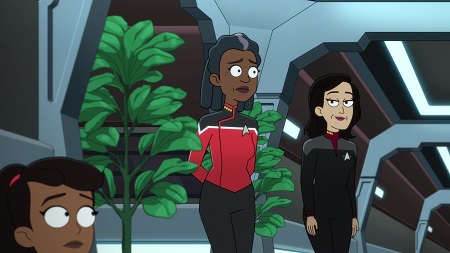
Since we mentioned Captain Freeman, let’s start there. It makes sense that, in light of her achievements particularly with the Pakled conflict but also in other areas, that she’d be a promotion target. She’s been a strong captain across the show’s first two seasons, and I’m sure that Starfleet is always on the lookout for officers like Captain Freeman. We’ve heard on a number of occasions that California-class ships are pretty low down in the Starfleet hierarchy, so transferring a senior officer from a “lowly” post to a more significant post is something I can absolutely imagine the organisation would do – it is, after all, a meritocracy.
What I didn’t like about this transfer storyline was the notion that Starfleet command appears to have essentially written off people like Billups, Shaxs, and especially Freeman’s first officer Commander Ransom. This is one of the aforementioned plot contrivances, as it was necessary for the senior staff to be upset with Captain Freeman to give this aspect of the story some more weight. But purely from an in-universe point of view, I didn’t really like that Starfleet was basically saying that the senior staff of the Cerritos are California-class quality and can never be anything more than that. It kind of undermines the meritocratic nature of the organisation that we were just celebrating!
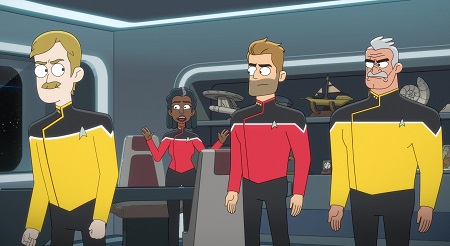
It was interesting to see the senior staff and Captain Freeman at odds with one another, though. That’s something Lower Decks hasn’t really tried before, and it worked well. Both sides are right in their own ways – Captain Freeman wanted to wait for the right moment to discuss the subject, especially with an important mission at hand. But the rest of the senior staff had every right to be upset at being kept out of the loop.
Mariner was, of course, the instigator of this drama. But her arc across the episode didn’t undermine her character progression that we’ve come to see and love over the past two seasons. Her acting out on this occasion wasn’t caused by a desire to be a chaotic troublemaker, but actually came from a place of genuine love. She’s come to enjoy working with her mother, especially since the events of Season 1’s Crisis Point and the unveiling of their family connection in Season 1’s No Small Parts. The idea that she was going to lose her mother after having only recently begun to enjoy their new dynamic was something she found impossible to deal with at first, prompting her to tell the senior staff and cause what she knew would be a fight.
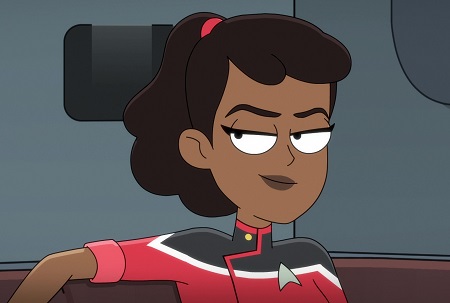
In some ways, the argument between Mariner and Freeman earlier in the episode – in which Mariner told the captain she’d never want to work with her ever again – did feel regressive. In the moment it seemed as though the progress Mariner had made in her relationship with her mother – which was also reflected in her attitude toward working in Starfleet – was slipping back to its early Season 1 state. But as the story moved along and we came to understand why Mariner was so upset it all made perfect sense and the pieces fell into place.
One of my favourite things about Lower Decks over its first two seasons as a whole has been the way Ensign Mariner’s characterisation has been handled, and First First Contact was the icing on the cake. We got to see firsthand just how much serving with her mother has come to mean to her, and how devastated she was at the thought of losing her. It wasn’t, as she claimed at first, because Captain Freeman would protect her from getting court-martialled! She genuinely came to care about their rebuilt relationship, and that changed her attitude toward at least some of the work she does as an ensign. It’s been a wonderful transformation to see play out, and it needed two full seasons with these moments scattered along the way to properly unfold.

We also got a moment between Tendi and Mariner that built on their solo adventure in We’ll Always Have Tom Paris earlier in the season. As Mariner was struggling, it was Tendi who snapped at her and finally got her to see sense. I loved her line about friendship, it really knitted together all of the loose ends of Mariner’s season-long character arc. We’ve learned how she’s been avoiding making friendships and pushing people away because she fears losing those friends when they inevitably move on, but as she found with Rutherford, Tendi, and Boimler she doesn’t have to be frightened of that. That conversation prompted her to rush to the bridge and have a heart-to-heart with the captain in what was perhaps the sweetest moment in the entire episode.
Jennifer the Andorian has been a background character this season, and if I were to nitpick Mariner’s storyline in First First Contact I’d say that the Jennifer rivalry wasn’t as well-developed as it could’ve been prior to its resolution at the end of the episode. We’d seen Mariner mention her a couple of times, particularly in the season premiere, Strange Energies. But Mariner’s big rivalry with a secondary character in Season 2 came with Jet in the episode Kayshon, His Eyes Open. There was enough of a Mariner-Jennifer conflict to make the way they resolved things work – and I loved seeing Jennifer come to Mariner’s rescue – but it could have been developed further before they sat down together.
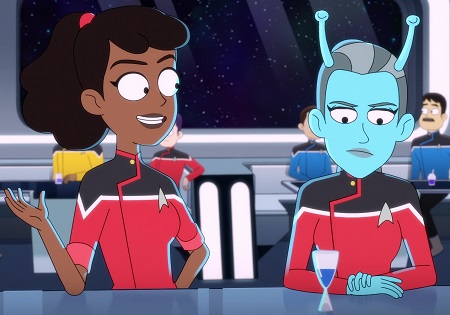
I wasn’t certain if Mariner’s line about “liking” Jennifer when they talked in the bar meant that she has a crush or some kind of romantic feelings toward her, though Jennifer’s reaction seemed to suggest that. Mariner has previously said that she’s dated males, females, and non-binary people, so I think we can infer that she’s pansexual and would thus not be averse to dating someone like Jennifer. Watch this space, because I think it could be interesting to give Mariner a romantic relationship in future.
Rutherford’s story was perhaps the shortest this week. He spent much of his time with Tendi, racing around the ship after she misunderstood Dr T’Ana and felt she was going to be transferred. The Tendi-Rutherford pairing has always worked well, and the pair revisited some of their earlier haunts, including the Jefferies tube where they spent time together in the episode Envoys back in Season 1.

His main concern this time came from his missing memories, and his desire to never again forget any part of his friendship with Tendi. It was very sweet that Rutherford would be so cautious about backing up his memories after losing them at the end of Season 1, but as with the only other real mention of this storyline this season, I feel like this story came a bit late in the day. Rutherford’s memory loss could have been more than Lower Decks ultimately made of it, and while this week it did lead to a couple of sweet moments both with Tendi and with Billups, I still feel it could’ve been handled better overall.
The visual gag of the pop-up was funny, though, and gave Rutherford a reason to let Tendi guide him – literally as well as figuratively. We know from episodes like Crisis Point that Rutherford has a great respect for Billups, so it made perfect sense for Billups to be the one he’d turn to for advice. He listened to Billups’ advice too, eventually deleting his backups to free up space in his implant.

Rutherford’s cyborg status had never been called into question. Everyone on the crew simply accepted him for who he was, and that appeared to be that! However, First First Contact has set up an interesting mystery in regards to Rutherford’s cybernetics: who were the mysterious figures seen augmenting him, and if he didn’t choose to be augmented voluntarily, why does he have his implant? I have no doubt this will be explored in Season 3, so watch this space!
Lower Decks has never been particularly bothered about borrowing themes and character types from Discovery, preferring instead to focus on The Next Generation era. But in Rutherford we have a character who has at least some similarities to Discovery’s Airiam – a character who really only came into her own shortly before her death in Season 2. Airiam was similarly a cybernetically-augmented human, though her cybernetics were a result of an accident she suffered. Rutherford’s suppressed memories could hint at a similar fate – perhaps he was injured while on some clandestine assignment for Starfleet. Maybe Section 31 are involved! In future I might write up some of my guesses about Rutherford’s pre-augmentation past, so be sure to stay tuned for that.

Though it went somewhat understated in the episode, Rutherford came up with the idea that ultimately saved the day – for the second season finale in a row! It was his plan to jettison the Cerritos’ outer hull that allowed them to make it through the asteroid field in time to save the USS Archimedes, and in an episode that wasn’t all about Rutherford it was nice that he got one of the most significant story moments. First First Contact had several key moments that mirrored the Season 1 finale, No Small Parts, and this was the first of them.
It never seemed plausible that Tendi was so bad at her job that she’d be kicked off the ship, and as mentioned this storyline did feel a little contrived. But it gave Tendi the opportunity to spend time with Rutherford and to give Mariner the talk that she needed to come to her senses and fix her relationship with Captain Freeman. I think it gets a pass in that regard!

“Overhearing something and misunderstanding it” is a bit of a sitcom cliché, but it was generally handled well in the episode, and the moments where Tendi felt like she had to run and hide from Dr T’Ana were kind of funny. It ultimately led to a cute resolution with the pair hugging it out – and Dr T’Ana purring! I’ve said on a number of occasions that I love how Lower Decks has played up the cat-like features of Dr T’Ana, and this was yet another example of that.
However, as a concept I’m not really sure I follow what this storyline wanted to say. Though medical and science are related departments they’re hardly the same thing, and transferring someone who wants to work in medical to a science position doesn’t necessarily feel like a promotion. To be fair, Tendi has never really settled into a specific role in a specific department on the ship – only Rutherford really feels settled as an engineer; the other three ensigns appear to get a variety of different roles depending on the needs of individual episodes. But having Tendi in sickbay has generally worked very well.
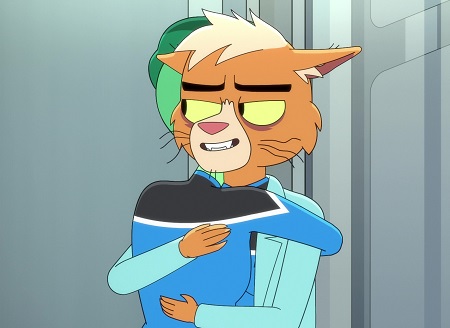
Tendi makes for a great medical officer, both from an in-universe and story point of view. We saw this firsthand this week when her quick thinking, ability to stay calm, and medical training helped her save Boimler’s life. Her kindness is a stark contrast to Dr T’Ana’s grumpy nature when dealing with patients, and she’s always seemed to know a lot about biology and medical science – even creating her own animal, The Dog, in the Season 1 episode Much Ado About Boimler. I just didn’t feel that Tendi was in any way trying to position herself for a transfer to a more scientific role, and as recently as I, Excretus a couple of weeks ago seemed thrilled at the idea of taking on the role of chief medical officer.
I wonder if this is just another contrivance for the sake of this episode, and whether we’ll actually see Tendi assigned to scientific bridge duties beginning in Season 3. It would be no bad thing to give her moments on the bridge, particularly if Mariner and/or Boimler are also present at the helm or navigation positions, so perhaps this should be seen more as an expansion of Tendi’s roles aboard the ship rather than a straight transfer. Hopefully shuffling her out of sickbay – if indeed it does happen – won’t mean we get to spend less time with Dr T’Ana; she’s one of my favourite characters!
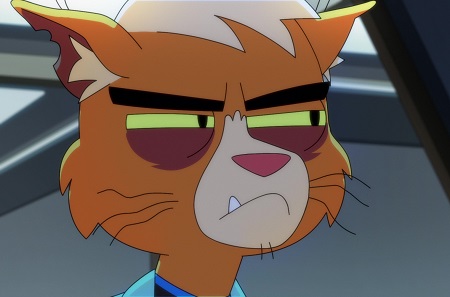
Boimler got some sweet moments this week. Making a banner for Captain Freeman – based on the famous “Captain Picard Day” banner that recently reappeared in the premiere episode of Star Trek: Picard – was incredibly cute, and I’m never not impressed with Boimler’s enthusiasm for his ship, his captain, and all things Starfleet.
He also got to save the day, diving down to release the final exterior hull panel while Mariner rushed to the bridge. Mariner, as mentioned, definitely needed this moment with Captain Freeman to resolve their conflict, but I liked that it gave Boimler the chance to play the hero for a change. We’ve seen Boimler step up while under pressure before, particularly in the episode Kayshon, His Eyes Open earlier in the season. But on this occasion his actions saved two starships and a whole planet – so that’s pretty great going!

The change in Boimler’s characterisation across Lower Decks’ first couple of seasons has been more subtle when compared with what we’ve seen from Mariner, but when we see Boimler being prepared to take on a difficult task like this, it’s hard to see how the Boimler we met at the beginning of Season 1 would’ve had the confidence to do so. His friendships with Tendi, Rutherford, and especially Mariner – as well as his jaunt aboard the Titan – have seen him grow in confidence. He still has his anxieties and neuroses, but he’s become a more confident person since we met him. That arc has likewise been incredibly satisfying, and culminates in moments like this one.
Are the dolphins aboard the Cerritos Earth dolphins, do we think? It was certainly implied that they could be based on their familiar dolphin chittering! If so, it raises a very interesting question: is Earth now home to more than one sentient life-form? We’d seen with the Xindi that multiple sentient races can evolve on a single world, so it isn’t impossible! Dolphins are, from a real-world point of view, very intelligent. So are crows, so maybe Lower Decks could introduce us to a sentient crow one day! Crows have, after all, recently entered their very own stone age. That might sound bonkers, but it’s true.
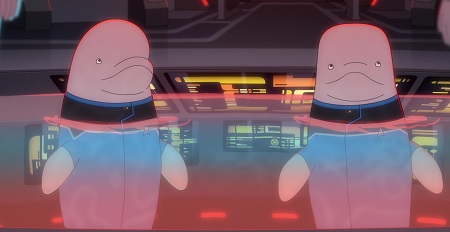
It was very sweet that First First Contact brought back the character of Sonya Gomez. We first met her in Q Who, back in Season 2 of The Next Generation, and in the years since she’s clearly done very well for herself – rising all the way to the rank of captain. Lycia Naff, who played the character in The Next Generation, made a welcome return to Star Trek to reprise her role.
Captain Gomez got a very sweet, very poetic moment with an ensign on the bridge of the Archimedes that harkened back to her famous clumsy moment with Captain Picard in Q Who. For us as the audience – and perhaps for the actor too – that moment was a cute way to bring things full-circle, as well as showing off just how much Gomez has grown and changed over the course of her career. She’s in charge of an Excelsior-class ship – and the design of one of my favourite ships was beautifully incorporated into Lower Decks’ animated style.
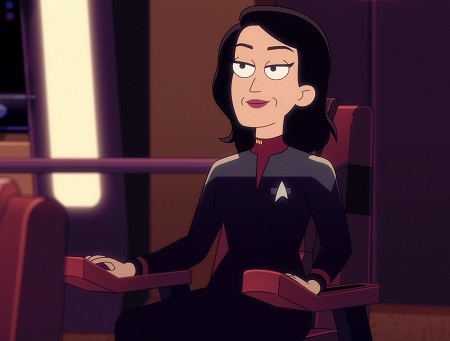
Unlike a couple of other guest-stars across both seasons of Lower Decks, Captain Gomez’s role felt substantial. She and her ship weren’t on screen the entire time, but the role they played was significant, both as a driving force for the events of the episode but also in its own right as the reappearance of a significant and well-liked character. It was handled well and it was great to see Captain Gomez in action once more.
In a moment of symmetry with the Season 1 finale, this time the USS Cerritos got to be the ship that saved the day! In No Small Parts the Titan, under the command of Captain Riker, came racing to the aid of the Cerritos when the battle against the Pakleds seemed to be going badly. In First First Contact it was the Cerritos that swooped in to save the Archimedes – and a bridge officer aboard Captain Gomez’s ship even used the same line as Boimler in the Season 1 finale: “it’s the Cerritos!” That moment really got me; it was perfectly poetic, and a fantastic way for the story to end.
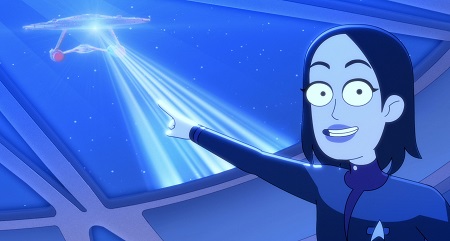
First First Contact presented the crews of the Cerritos and Archimedes with a scientific problem, not a military one. It’s easy to think that Star Trek is at its most exciting and action-packed when there are enemies to fight and battles to participate in, but for me the franchise has always been at its best when it’s looking at exploration and scientific puzzles. First First Contact absolutely epitomises the spirit of Star Trek as a show about science, exploration, and the wild, wonderful, and occasionally dangerous galaxy that awaits humanity beyond Earth.
By presenting the crew with a scientific puzzle, one that wasn’t easy to solve, First First Contact showed how amazing and exciting Star Trek can be when there are no Borg or Klingons or Pakleds bearing down on our heroes. The episode was so well-paced that we really got a sense of this race against time to get the ship ready to race through the asteroids and rescue not only the Archimedes but the planet it was threatening to crash into.
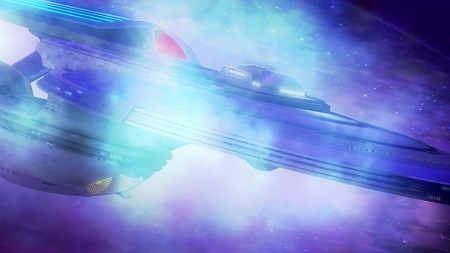
I was a little concerned, particularly as Commander Ransom did his best to navigate the asteroid field, that there’d be some kind of deus ex machina ending – the Archimedes would have saved itself or another ship (like the Titan) would have beaten the Cerritos to the punch, with the joke being that all of the crew’s hard work was for nothing. As a comedy series first and foremost, that kind of storyline is always a possibility. But having seen Captain Freeman and the whole crew go to so much effort such an ending would have really fallen flat, and I’m glad that, on this occasion at least, Lower Decks allowed the crew a huge win.
Rescuing the Archimedes was a very emotional moment in what was already an emotional story. The crew came together, despite their initial differences, and pulled off a one-of-a-kind rescue mission. We’ve never seen the likes of this in Star Trek before, yet the idea of stripping off a ship’s outer hull when not at warp feels like it fits perfectly with what we know of the way starships work. It was a fantastic story idea, and it came to fruition perfectly in the finished episode.
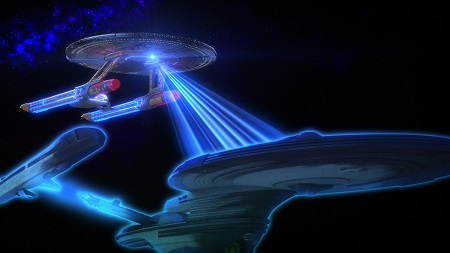
So we come to the final scenes! After expecting to be offered a promotion, Captain Freeman was arrested by Starfleet security, charged with bombing the Pakleds’ homeworld. This was a truly unexpected twist; it had seemed as though wej Duj last week wanted to draw a line under the Pakled conflict storyline. It was, somewhat unfortunately, the second “misunderstanding” scene after Tendi’s conversation with Dr T’Ana, but I guess that couldn’t be helped.
This epilogue was almost certainly added into the episode later, once the team knew that Season 3 was officially confirmed, as it didn’t flow at all from anything else in the story. It’s left Lower Decks on a cliff-hanger – one which we’ll have to wait a long time to see resolved! That’s not new for Star Trek, of course, as many seasons have done something similar in the past. It was definitely a shocking twist, and it was very well-executed. Even as Captain Freeman walked into the room I had no idea what was about to happen.
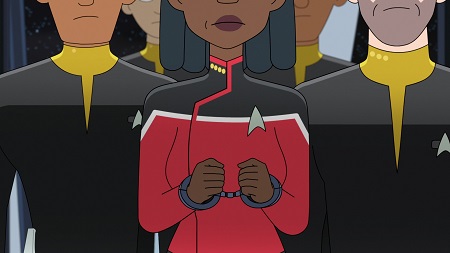
Obviously we know Captain Freeman is innocent – and surely she’ll be able to prove that. But we won’t get to see how that happens until Lower Decks returns next year (well, I hope it’ll be next year!) so I guess we’ll have to sit on our hands until then! Did the Pakleds accidentally blow up their own planet? Or did the rogue Klingon commander from wej Duj plant the bomb as a contingency plan to ensure war would break out? There are a few different possibilities – but if Season 2 has been any guide, Lower Decks won’t go down any path that we might expect!
So that was First First Contact – and that was Lower Decks Season 2! There were a couple of episodes that didn’t hit every high note that I’d have wanted, but overall the season as a whole was fantastic. We got some incredibly fun Star Trek hijinks with the crew of the Cerritos, plenty of unexpected twists and turns, the return of several classic characters, and some wonderful moments of characterisation and drama. It’s been an outstanding ten weeks – and I can hardly wait for Season 3.
Stay tuned here on the website, because sometime soon I’ll write up a retrospective look at Season 2. There are also a couple of theories relating to the Pakled bomb and to Rutherford’s background that might get the full write-up treatment in the run-up to Season 3. Although Season 3 is undoubtedly a long way off – ten months or more, at least – if and when we start to get information about the series, casting announcements, or a teaser trailer I’ll also be taking a look at those as well. It’s sad to bid farewell to Lower Decks – but it’s only a couple of weeks now until Prodigy arrives!
Star Trek: Lower Decks Season 2 is available to stream now on Paramount+ in the United States, and on Amazon Prime Video in the UK and around the world. The Star Trek franchise – including Lower Decks and all other properties mentioned above – is the copyright of ViacomCBS. This article contains the thoughts and opinions of one person only and is not intended to cause any offence.




